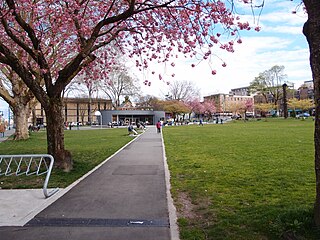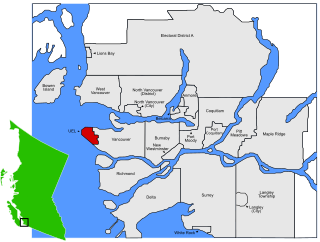Related Research Articles

Victoria is the capital city of the Canadian province of British Columbia, on the southern tip of Vancouver Island off Canada's Pacific coast. The city has a population of 91,867, and the Greater Victoria area has a population of 397,237. The city of Victoria is the 7th most densely populated city in Canada with 4,405.8 inhabitants per square kilometre (11,411/sq mi).

Bowen Island, British Columbia, is an island municipality that is part of Metro Vancouver. Bowen Island is within the jurisdiction of the Islands Trust. Located in Howe Sound, it is approximately 6 kilometres (3.7 mi) wide by 12 kilometres (7.5 mi) long, with the island at its closest point about 3 kilometres (1.9 mi) west of the mainland. There is regular ferry service from Horseshoe Bay provided by BC Ferries, as well as semi-regular water taxi services. The population of 4,256 is supplemented in the summer by roughly 1,500 visitors, as Bowen Island regularly receives travelers in the summer season. The island has a land area of 50.12 km2 (19.35 sq mi).

Nanaimo is a city on the east coast of Vancouver Island, in British Columbia, Canada. As of the 2021 census, it had a population of 99,863, and it is known as "The Harbour City." The city was previously known as the "Hub City," which was attributed to its original layout design, whose streets radiated from the shoreline like the spokes of a wagon wheel, and to its central location on Vancouver Island. Nanaimo is the headquarters of the Regional District of Nanaimo.

The Burrard Peninsula is a peninsula in the Lower Mainland region of British Columbia, Canada, bounded by the Burrard Inlet to the north, the Georgia Strait to the west, the North Arm of Fraser River to the south, and the Pitt River and Douglas Island to the east. The City of Vancouver occupies almost all of the western half of the peninsula, and the Cities of Burnaby and New Westminster occupy more than half of the eastern half. At its northeastern end, the peninsula is connected to the Eagle Mountain and Mount Burke of the Coast Mountains via a small isthmus at the center of the Tri-Cities.
Steveston, founded in the 1880s, is a neighbourhood of Richmond in Metro Vancouver. On the southwest tip of Lulu Island, the village is a historic port and salmon canning centre at the mouth of the South Arm of the Fraser River. The early 1900s style architecture attracts both the film and tourism industries.

Collingwood School is an independent, non-denominational, co-educational, university-preparatory school founded in 1984. Located in West Vancouver, British Columbia, Canada, it delivers the British Columbia Ministry of Education curriculum from Junior Kindergarten to Grade 12.

The Musqueam Indian Band is a First Nations band government in the Canadian province of British Columbia. It is the only First Nations band whose reserve community lies within the boundaries of the City of Vancouver.

Arc'teryx is a Canadian high-end design company specializing in outdoor apparel and equipment headquartered in North Vancouver, Canada. It focuses on technical apparel for mountaineering and Alpine sports, including related accessories. The company's name and logo reference the Archaeopteryx, the transitional fossil of early dinosaurs to modern dinosaurs (birds). Arc'teryx is known for their waterproof Gore-Tex shell jackets, knitwear, and down parkas.

Riley Park–Little Mountain is a neighbourhood in Vancouver, British Columbia. Its boundaries are 41st Avenue to the south, 16th Avenue to the north, Cambie Street to the west, and Fraser Street to the east. The main commercial thoroughfare of the neighbourhood is Main Street.

Arbutus Ridge is an affluent residential neighbourhood in Vancouver's West Side. It is bordered by 16th Avenue in the north, 41st Avenue in the south, Mackenzie Street in the west, and East Boulevard in the east. The neighbourhood is characterized by larger than average lot sizes, with stately homes on tree-lined streets.

Iona Island in Richmond, British Columbia, Canada was formerly an island, but is now a peninsula physically connected to Sea Island via a causeway and Ferguson Road. Iona is home to a primary sewage treatment plant, an animal refuge and a park. The Iona Sewage Plant is located near the centre of the island and has tours for the public. Iona Beach Regional Park also features a beach adjacent to wildlife from the nearby animal refuge. The park is managed by Metro Vancouver. Iona Island is located almost adjacent to the Vancouver International Airport. The park is mostly visited by birders, as the sewage ponds have attracted many rare shorebirds such as Spoon-billed Sandpiper, Great Knot, and Red-necked Stint.

Shaughnessy is an almost-entirely residential neighbourhood in Vancouver, British Columbia, Canada, spanning about 447 hectares in a relatively central locale. It is bordered by 16th Avenue to the north, 41st Avenue to the south, Oak Street to the east, and East Boulevard to the west. The older section of the neighbourhood, called "First Shaughnessy," is considered more prestigious and is bordered by 16th Avenue to the north, King Edward Avenue to the south, Oak Street to the east, and East Boulevard to the west. In 2016, the population was approximately 8,810. It was named after Thomas Shaughnessy, 1st Baron Shaughnessy, former president of the Canadian Pacific Railway.

The Marion Malkin Memorial Bowl, or Malkin Bowl, is a 2000-seat outdoor theatre in Stanley Park, Vancouver, British Columbia, Canada. Malkin Bowl is home to Theatre Under The Stars, which stages family-friendly Broadway musicals there.
The Artificial Reef Society of British Columbia (ARSBC) is a registered non-profit society based in Vancouver, British Columbia (BC), and is a registered tax-deductible charity in Canada.

Oppenheimer Park is a park located in the historic Japantown (Paueru-Gai) in Downtown Eastside, Vancouver, British Columbia, Canada.
Gambier Island is an island located in Howe Sound near Vancouver, British Columbia. It is about 17,049 acres in size and is located about 10 kilometres north of the Horseshoe Bay community and ferry terminal in westernmost West Vancouver.

Deadman Island is a 3.8 ha island to the south of Stanley Park in Coal Harbour in Vancouver, British Columbia. The indigenous Squamish name is "skwtsa7s", meaning simply "island." Officially designated "Deadman Island" by the Geographical Names Board of Canada in 1937, it is commonly referred to as Deadman's Island. It has been a battle site, a native tree-burial cemetery, smallpox and squatter settlement in its long history. Today it is the site of Vancouver's Naval Reserve Division, HMCS Discovery.

The Elk/Beaver Regional Park is a 1,072-acre (434 ha) park in Saanich, British Columbia, containing Elk Lake and Beaver Lake.

Mudge Island is one of the Southern Gulf Islands in the Salish Sea, in British Columbia (BC), Canada. It lies between Gabriola Island and Vancouver Island, and is considered part of the De Courcy group of islands. It is about 0.8 km (0.50 mi) wide and 4 km (2.5 mi) long. Dodd Narrows separates Mudge Island from Vancouver Island and False Narrows separates it from Gabriola Island. The northern tip of the island is the southern limit of the Port of Nanaimo and the southern most point of Northumberland Channel. Stuart Channel is south of Mudge Island.

The University Endowment Lands (UEL) is an unincorporated area that lies to the west of the city of Vancouver, British Columbia, Canada, and adjacent to the University of British Columbia (UBC) and the lands associated with that campus. Pacific Spirit Regional Park lies within the UEL. The UEL is part of Metro Vancouver. Mail sent to the UEL is addressed to "Vancouver" rather than the UEL.
References
- ↑ Whysall, Steve (September 5, 1992). "Down on Deering Island, where luxury living floats along". The Vancouver Sun. p. C5. Retrieved July 7, 2022– via Newspapers.com.
- ↑ "Deering Island Park". City of Vancouver. Retrieved July 7, 2022.
Coordinates: 49°13′03″N123°10′58″W / 49.21750°N 123.18278°W